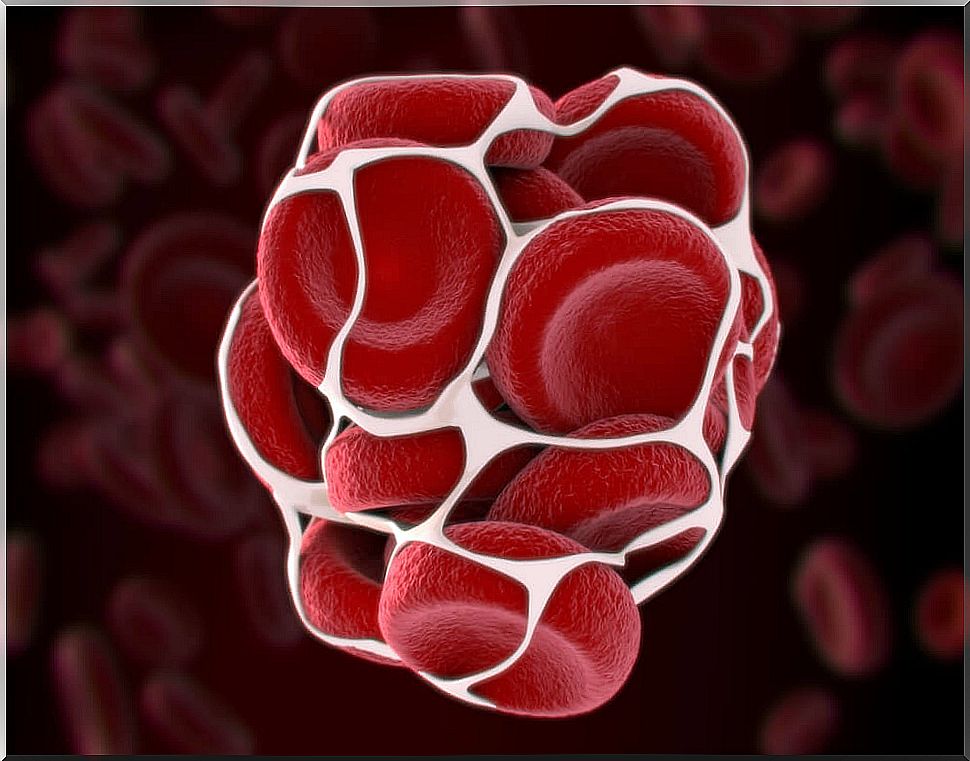Acenocoumarol: Mechanism Of Action And Interactions
Acenocoumarol is the active ingredient in the drug marketed under the name Sintrom.
It is a drug with anticoagulant properties. That is why it is prescribed to prevent the formation of blood clots.
Its mechanism of action is based on acting against vitamin K. This vitamin is essential to start the coagulant mechanisms.
It is practically identical to warfarin ( Coumadin ), since both belong to the group of coumarin anticoagulants. However, its use is more widespread in Anglo-Saxon countries. On the other hand, Sintrom is the most widely used anticoagulant in our environment.
How does blood clot?

Under normal conditions, clotting is triggered by bleeding , preventing blood loss. In this way, for example, in the face of an attack that causes a wound, a series of mechanisms are activated that stop the bleeding.
These mechanisms can be divided into two groups, depending on their function at the time they act:
- The primary mechanisms act practically immediately after the assault
- Secondary mechanisms take a little longer to act.
After the assault, the walls of the blood vessel that has been injured narrow. This process is called vasospasm. Thus, its objective is to limit the amount of blood that passes through the damaged vessel to prevent its loss. Next, the platelet plug is formed. Platelets adhere, on the one hand, to the collagen of the damaged vessel and, on the other, to each other.
After this first phase, the coagulation cascade starts. Eventually, a firm, insoluble fibrin clot forms, preventing bleeding. For this, a series of sequential reactions are produced in which the main protagonists are the coagulation factors.
What are clotting factors?
It is about 13 molecules of a protein nature. They are those that intervene in the cascade of coagulation reactions . They activate each other, until eventually the fibrinogen turns into fibrin and the clot forms.
Some of them need vitamin K to be activated, and therefore, to exert its function. Activation takes place in the liver through a process called gammacarboxylation. Factors II, VII, IX and X and proteins C and S are vitamin K dependent.
Mechanism of action of acenocoumarol

The acenocumarol acts as “antivitamin K”. Thus, it inhibits a process that takes place in the liver called gammacarboxylation, for which this vitamin is essential. If this is not carried out, the clotting factors that depend on vitamin K are not activated.
Once the vitamin K-dependent clotting factors are in the non-active state, the clotting cascade cannot be performed. It is because of this that the blood remains in a liquid state.
When is acenocoumarol prescribed?
It is the drug of choice for the treatment and prophylaxis of thrombotic diseases. Likewise, on many occasions it is prescribed preventively after surgical interventions. This occurs especially after an intervention in traumatology, for example knee, hip… operations. Some examples of diseases treated with acenocoumarol are:
- Deep vein thrombosis and pulmonary embolism.
- Prevention of thrombus formation in “hypercoagulable states”. It is indicated in people who have suffered a thrombotic accident before. Hypercoagulable states are pathologies that predispose people to clot their blood and form a thrombus.
- In young patients with recurrent thrombosis in which there are no known risk factors.
- Prevention of thrombus formation and consequent embolism in heart disease .
In this context, prevention in atrial fibrillation and valve diseases is of special importance. In addition, people with prosthetic valves or who have undergone cardioversion should also be treated.
When is it contraindicated to take acenocoumarol?

Acenocoumarol is basically contraindicated in any situation where there is a high risk of bleeding. In addition, its use will be avoided in the following cases:
- Having active gastric ulcer and diverticulitis.
- In people with a dissecting aortic aneurysm.
- When there is a history of recent cerebral hemorrhage or of recent ocular or cerebral surgery.
- In cases of hypertension or severe kidney or liver failure.
- People with urological, lung or digestive cancer.
Interactions
In a very simple way, taking other medications together with acenocoumarol can alter its effects. There are medications that can enhance its effects, while there are others that can decrease them.
Some examples of medications that can enhance its effects are:
- Anabolic steroids (the popular “anabolics”).
- Androgynous hormones (hormone replacement treatments).
- Some antiarrhythmics, such as amiodarone or quinidine.
- Some antibiotics, such as erythromycin or tetracyclines.
- Clofibic acid and its derivatives.
- Thyroid hormones used in replacement treatments.
On the contrary, other medicines can reduce its effects, for example:
- Oral contraceptives.
- Barbiturates.
- Griseofulvin.
- Carbamazepine.
Likewise, acenocoumarol can also enhance or decrease the effects of other medications. For example, taking acenocoumarol and hydantoin derivatives together increases the concentration of the latter in the blood, enhancing their effect. Some derivatives of hydantoin are phenytoin (anticonvulsant), or dantrolene, used to treat malignant hyperthermia.
Other drugs that enhance its effects are oral antidiabetics. In these cases, the seriousness lies in the fact that the hypoglycemic effect is enhanced. Because of this, the “sugar drop” is greater.
Excessive alcohol consumption is also totally contraindicated. The effects of this interaction cannot be known in advance. Likewise, taking the drug with St. John’s wort is not recommended.
In case the doctor has prescribed acenocoumarol, or has informed you that he is going to do so, be sure to tell him about all the medications you may be taking. Likewise, you should also inform your doctor if you have had stomach or bowel surgery.
Acenocoumarol overdose: bleeding
The result of an overdose of this drug is bleeding.
To stop them, it is usually enough to remove the acenocoumarol. In more serious cases, vitamin K will be administered in progressive increase until it is controlled.








